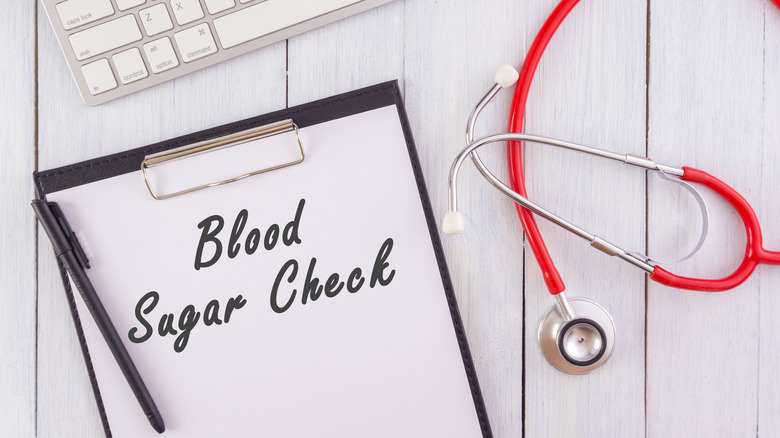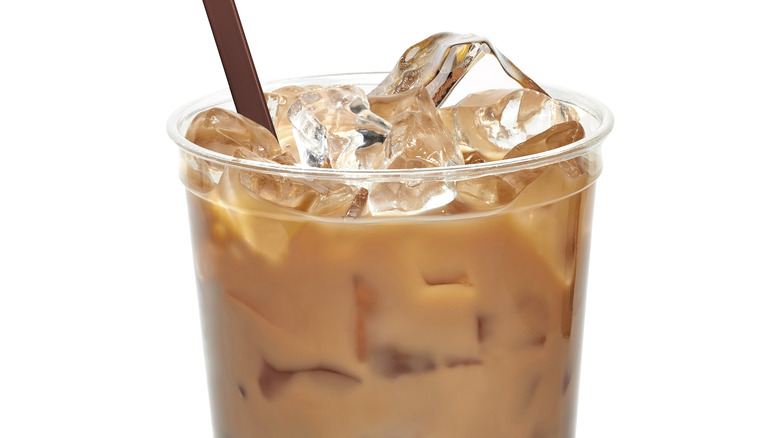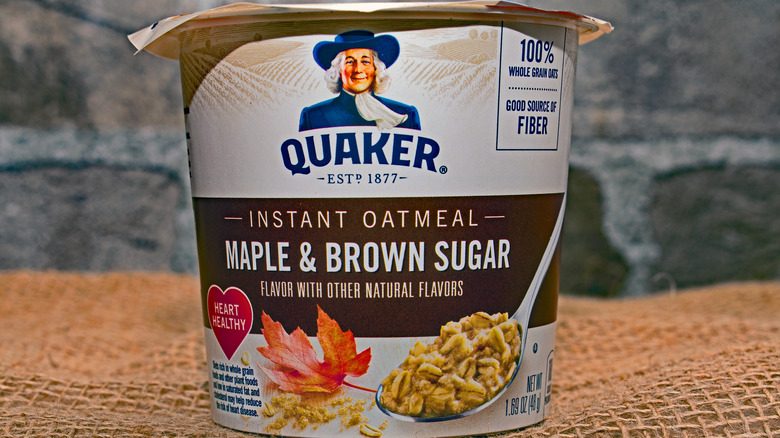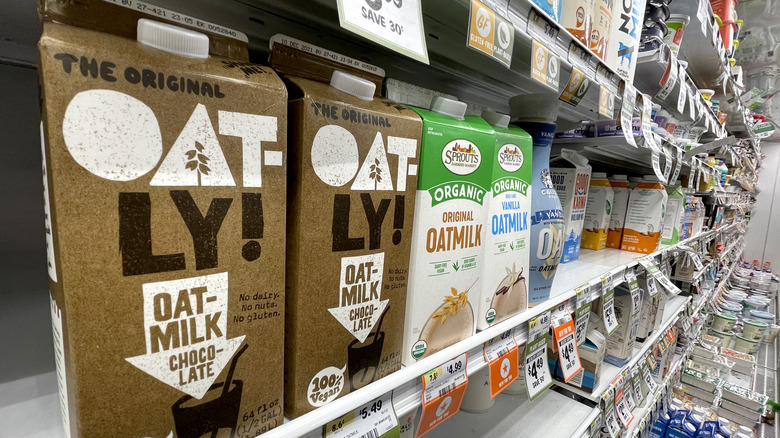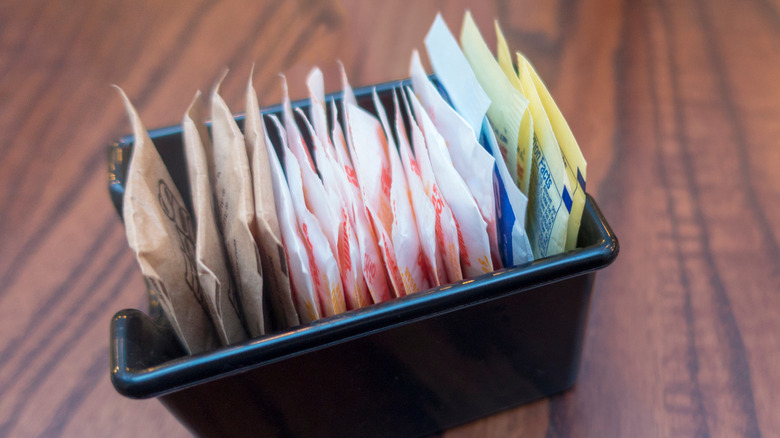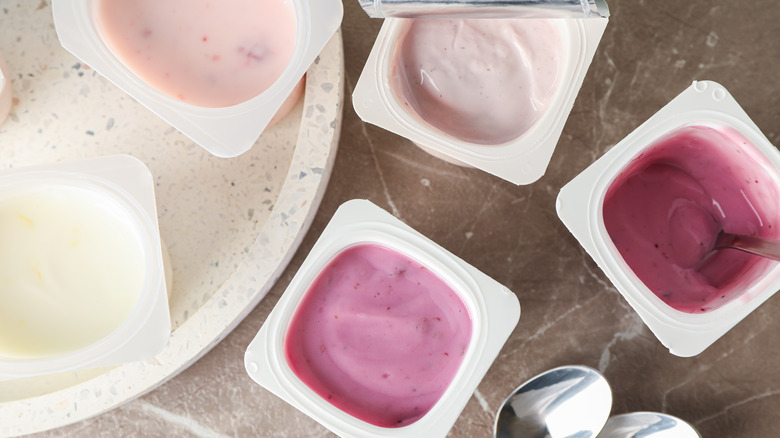12 Foods You Probably Never Knew Were Bad For Blood Sugar
Maintaining healthy blood sugar levels is a challenge for many people, and knowing which foods affect it is crucial. According to the Centers for Disease Control (CDC), as of 2021, 37.3 million Americans have type 2 diabetes. As the Mayo Clinic notes, this condition arises when the body has problems using and regulating sugar, which leads to high blood sugar levels. The CDC also notes an additional 96 million American adults have prediabetes, and at least 8 out of 10 people with this condition don't even realize it.
But you don't need to be diabetic or prediabetic to feel the effects of a blood sugar spike. Healthline notes that short-term symptoms of high blood sugar — also called hyperglycemia — include fatigue, headaches, frequent urination, and blurred vision. Continued high blood sugar can lead to an increased risk of nerve damage, cardiovascular disease, organ damage, and kidney problems, per Better Health Channel.
Some foods and beverages are widely known to be bad for blood sugar levels, including candy and soda. Other foods, though, may be affecting your blood sugar without you even knowing; as WebMD notes, it's not just sugar that causes spikes. Here's a look at 12 foods you probably didn't know are bad for blood sugar and how you might counter the effects.
1. Potatoes
Simply put, people love potatoes. The average American eats 126 pounds of spuds every year, according to the Harvard School of Public Health — and as the Helgi Library found in 2019, China and India residents eat even more. But all those french fries, mashed potatoes, chips, and hash browns could be wreaking havoc on your blood sugar.
The Harvard School of Public Health goes on to note that potatoes are high in rapidly-digested carbohydrates, which enter the bloodstream quickly and cause blood sugar levels to surge. To quote, "a cup of potatoes has a similar effect on blood sugar as a can of cola or a handful of jelly beans." Furthermore, a 2006 study published in the American Journal of Clinical Nutrition found an association between potato consumption and the risk of developing type 2 diabetes — especially when the potatoes are replacing whole grains.
How can you enjoy potatoes without blood sugar spikes? Medical News Today has several suggestions, which include letting the potatoes cool down before consuming, which slows digestion, or choosing taters that have a lower glycemic index, such as carisma potatoes and sweet potatoes. You can also leave the skins on, which increases your fiber intake and thus slows digestion so blood sugar doesn't rise as
2. White rice
If you thought potatoes were popular, you should hear about rice. White rice is by far the most common variety since it's easier to transport, cooks faster, and has a longer shelf life (via Financial Review). However, this comes at a cost. Healthline notes that white rice is refined to remove the bran and germ. Among other things, this means your body digests it faster, which causes blood sugar rushes. A 2012 research review by the Harvard School of Public Health found regular consumption of white rice can increase the risk of developing type 2 diabetes. Harvard Medical School puts it more bluntly, saying that eating white rice "has almost the same effect as eating pure table sugar."
There are alternatives, though — and you don't even need to give up rice. Heathline adds that unrefined brown rice has a glycemic index of 50 compared to white rice's 89 on a scale of 100. This means brown rice digests slower, and it also has more fiber, niacin, magnesium, and other key nutrients.
A 2018 study published by The Journal of Nutrition found another interesting alternative. As summarized by Science Daily, researchers at the University of Guelph discovered that by swapping half your rice portion for lentils, you can lower blood sugar levels by 20%. Not only that, but the results were similar regardless of the type of lentil.
3. Coffee drinks
Nearly two-thirds of Americans drink coffee every day, according to a 2022 report by the National Coffee Association (NCA); and you could be getting a blood sugar spike on the side. As Levels Health notes, coffee itself doesn't contain any sugar or carbohydrates. But about 38% of U.S. coffee drinkers add sugar and almost 7 out of 10 infuse their brew with some sort of coffee whitener, such as milk or cream (via Vending Market Watch).
These sweeteners add up fast. Simply ordering a medium iced coffee from Dunkin' Donuts with standard cream and sweetener gives your drink 27 grams of sugar. Furthermore, flavored coffee could be even more harmful to blood glucose levels, as a Grande Caffè Vanilla Frappuccino from Starbucks nets 64 grams of sugar. By comparison, a can of Monster Energy Drink has 54 grams (via Beastly Energy). The NCA says the average American coffee drinker drinks 3.1 cups of coffee a day — think about drinking that sugar bomb 3.1 times.
The good news is that, for most people, plain coffee typically does not affect blood sugar (via Medical News Today). However, Diabetes Daily notes several studies have found caffeine can cause hyperglycemia in people who already have type 2 diabetes. The effect varies from person to person, though, and some diabetics can drink all the unsweetened coffee they want without a blood sugar surge.
4. Fruit juice cocktails
It's easy to think of fruit juice as a healthy alternative to soda and energy drinks. After all, it has "fruit" right in the name. But research indicates these drinks aren't all they're cracked up to be — especially fruit juice cocktails. As Medical News Today notes, fruit punch and other beverages often contain very little real fruit juice and a huge dose of sugar, corn syrup, or other sweeteners. For example, Ocean Spray Original Cranberry Juice Cocktail is only 27% juice and contains 23 grams of added sugar per serving. A 2015 study in the British Medical Journal found fruit juice cocktails can cause the same blood sugar spikes and increased risk of type 2 diabetes as soda does.
Fortunately, it appears that 100% fruit juice is a better blood sugar alternative. A 2017 Journal of Nutritional Science review concluded that 100% fruit juice "does not have a significant effect on glycaemic (sic) control or measures of insulin resistance." Still, Diabetes Self-Management notes that 100% juices do have a lot of natural sugar and carbohydrates. They also note juice doesn't contain fiber like fresh fruit does and is much easier to overconsume. As such, they recommend watching your juice portions and drinking it as part of a meal — and opting for fresh fruit whenever possible.
5. Ketchup and barbecue sauce
While many condiments contain blood glucose-spiking sugar and carbs, ketchup and barbecue sauce are particular culprits. At first glance, it might not appear ketchup would be so bad; a 1-tablespoon serving of classic Heinz ketchup contains 4 grams of sugar. However, Statista reports the average American consumed 5.2 liters of the condiment in 2021, which equates to nearly 7 tablespoons a week. Furthermore, as Scott Johnson writes for Healthline, a typical McDonald's paper ketchup cup holds about two servings, making it easy to overconsume. With worldwide revenue for the condiment expected to grow more than 27% from 2022 to 2026, that ends up being a lot of sugar.
Barbecue sauce may have an even bigger effect on hyperglycemia. To make an example of Heinz again, their Original Sweet & Thick BBQ Sauce has 18 grams of sugar per a 2-tablespoon serving. Even after accounting for serving size, that's more than double what their ketchup contains by volume. And, as we all know, sometimes it's hard to limit yourself to just one serving.
If you have the urge for either condiment, look for low-sugar options. To their credit, Heinz has introduced a No Sugar Added Tomato Ketchup. Aside from Heinz, there are plenty of low-sugar sauces from other brands. Annie's Organic Original BBQ Sauce only contains 3 grams per serving, and G Hughes Sugar Free BBQ Sauce has no sugar at all. Some smart shopping will let you enjoy dipping and topping without excess sugar.
6. Instant oatmeal
Some types of oatmeal are considered fine for blood sugar, but instant oats are another story. As detailed by Diabetes Strong, instant oats (aka quick oats) have been processed more than steel-cut or rolled oats. While this allows them to cook faster and still maintain similar nutritional properties to rolled oats, it also increases their glycemic index (GI) since the oats are digested faster. A systematic review in the British Journal of Nutrition found that steel-cut and rolled oats have a GI of 53-55 while instant oats have a GI of 71-75. In turn, these oats showed a higher glycemic response — in other words, a blood sugar spike.
Further complicating things is that many instant oats also have added sugars and sweeteners. For example, according to Nutritionix, Quaker Instant Oatmeal Maple and Brown Sugar has 12 grams of sugar and 33 grams of carbohydrates.
Conversely, Quaker Oats Old Fashioned rolled oats have only 1 gram of sugar and 27 grams of carbs. They also have more fiber and protein, which help slow digestion. Sticking with the less-processed steel-cut oats or rolled oats will help regulate your blood sugar while providing additional health perks compared to highly refined instant oats or breakfast cereals (via Healthline).
7. Non-dairy milk
Drinking plant-based milk and other non-dairy milk can provide a lot of benefits. As registered nutritionist Dr. Sue Reeves tells Medical News Today, alternative milks are ideal for to those who have dairy allergies, are lactose-intolerant, or want to be more eco-conscious.
But watch out that you aren't getting a large dose of blood sugar along with your plant-based beverage. Dr. Reeves goes on to note that many alternative types of milk contain more additives than typical cow's milk — including added sugar. In their raw form, milk alternatives also lack protein and other nutrients that slow digestion, which means the sugar is absorbed into the bloodstream faster than with regular milk.
Rice milk may be the worst offender. Harvard Medical School points out that rice milk has an average glycemic index (GI) of 86, which is higher than white bread, soda, and other known blood sugar triggers, and more than double the 39 rating of full-fat dairy milk. On the other hand, soy milk is listed with a GI of 34. While raw oat milk is even better with a GI of 30 according to the Glycemic Index and Glycemic Load Guide, you still need to watch out for those added sugars — such as the 17 grams in each serving of Pacific Foods Organic Oat Original. When it comes to grain, seed, and nut milk, Harvard Medical School recommends looking for unsweetened products that have been fortified with protein and calcium.
8. Artificial sweeteners
For many years, artificial sweeteners were considered safe options for blood sugar levels and even a "free food" for diabetics, as detailed in this 2017 Healthline article. But more recent research indicates that, at least for certain sweeteners, things aren't as rosy as previously thought. In fact, multiple studies have indicated that certain sugar substitutes can actually increase blood sugar.
In a 2022 study published by Cell, researchers found that consuming saccharin and sucralose significantly spiked the blood sugar levels of participants. Two separate studies in Diabetes Care and the Journal of Family Medicine and Primary Care also found that sucralose can increase the body's glycemic and insulin responses — and could further increase insulin resistance in those who already have type-2 diabetes. Finally, NBC News notes a growing consensus that artificial sweeteners hurt the body's ability to process actual glucose, which elevates the risk of diabetes and cardiovascular diseases.
It's not all bitter, though. A 2020 study in the Avicenna Journal of Phytomedicine determined that stevia, another popular non-nutritive sweetener, had no significant effect on blood glucose and insulin levels. Still, the evidence is clear that people shouldn't treat artificial sweeteners as a "get out of jail free" card when it comes to blood sugar and their overall health.
9. Flavored yogurt
A study published in The Journal of Nutrition in 2017 found there are many benefits to plain yogurt, including a lower risk of developing type 2 diabetes. The American Diabetes Association (ADA) even approves yogurt for a diabetic's diet plan.
Unfortunately, though, not every yogurt is equal on the blood sugar tree. Medical News Today observes that many manufacturers add sugar to help their yogurt taste better. As Cheryl Mussatto tells Eat This, Not That!, the worst yogurts for blood sugar are the ones marketed to children. Mussatto says, "These yogurts typically are high in sugar and low in protein, a bad combination for keeping blood sugar in check." Just look at Yoplait Go Gurt Strawberry & Mixed Berry yogurt pouches — they contain 23 grams of sugar per serving (18 grams added) and a relatively low 6 grams of protein.
But adult-oriented yogurts aren't innocent, either. Dannon Vanilla Lowfat Yogurt, for example, has 22 grams of sugar in a 5.3-ounce single-serve cup. In fact, sugar is the second ingredient on the label! To limit blood sugar spikes, DiaTribe Learn recommends unflavored yogurts sweetened with natural ingredients, such as fresh fruit and chia seeds. Greek and Icelandic varieties can also prevent peaks and valleys since they're higher in protein than traditional yogurt.
10. Honey
Honey has long been considered a healthy alternative to white table sugar. And, as Medical News Today notes, it does contain many beneficial nutrients, such as amino acids, antioxidants, vitamins, and minerals. But in terms of blood sugar, the gap may not be so big. According to WebMD, honey has a glycemic index score of 58, which is only two points lower than white sugar, and 1 tablespoon of raw honey contains 17 grams of total sugar from glucose and fructose. Medical News Today observes that honey actually has more sugar by volume than white sugar.
Research varies somewhat on exactly how much honey affects blood glucose levels. A study in the Journal of Medicinal Food in 2004 found that, while honey initially raises blood sugar, levels return to normal sooner than they do with white sugar. However, in 2009, an eight-week clinical trial determined that adding honey to the diets of type 2 diabetics significantly increased overall blood sugar levels, though it did provide other benefits, such as healthier body weight and cholesterol levels (via International Journal of Food Science and Nutrition).
The obvious conclusion is that it's possible to consume too much honey or white sugar. If choosing honey, Medical News Today recommends dark and raw varieties since these are more nutrient-rich.
11. Heathy breakfast cereals
Sugary breakfast cereals aimed at children are a prime target of health crusaders, and they are certainly justified in this. The Environmental Working Group points out that some cereals, such as Honey Smacks and Cap'n Crunch, can be up to 56% sugar by weight. But many so-called "healthy" cereals can't be let off the hook. Healthline notes most cereals, even the "healthy" ones, contain lots of simple carbohydrates that the body digests quickly. Corn-based cereals are the worst in this regard. The average cornflake has a glycemic index score of 93 out of 100, meaning a flood of blood sugar to the system. The Diabetes Council confirms this assessment, noting regular bowls of cornflakes — even unflavored varieties — could increase the risk of type 2 diabetes.
You need to watch out for added sugar in those "healthy" cereals, too. Kellogg's Frosted Mini-Wheats have 12 grams of added sugar per serving. Post Raisin Bran, meanwhile, has 9 grams of added sugar and 20 grams of total sugar — nearly twice as much as in a serving of Lucky Charms.
So, what should you search for in a blood-sugar-friendly cereal? In addition to avoiding added sweeteners — either in the box or from your kitchen cupboard — Verywell Health suggests looking for cereals that list whole grain as the first ingredient and are high in fiber, which will regulate digestion. Healthline adds that wheat bran-based cereals are the best for blood sugar, especially compared to corn- or rice-based options.
12. Bagels
A bagel is seen by many as a healthier morning replacement for donuts, pastries, and other sugar-loaded bread products. But when it comes to blood sugar, perception and reality don't mix.
Although bagels and English muffins don't have much pure sugar, Medical News Today notes that they are made with a lot of processed sugar and flour, turning them into landmines of starchy carbs. As the Gaples Institute adds, those carbohydrates are ultimately converted into sugar anyway during digestion. As a result, the average bagel has a glycemic load (GL) of 33, which is nearly double the average glazed donut.
Not sure what that means? Oregon State University explains that glycemic load is a variation of the glycemic index that adjusts for serving size. Any GL score of 20 or more is considered high, which makes that 33 even more mind-boggling.
If you're still craving a bagel, Livestrong suggests going with whole grain types that are balanced by fruits, protein, and other food groups. A bagel sandwich is a great example. They also recommend eating mini bagels instead of large ones and counting a bagel as multiple starchy food servings in your diet plan. Even something as simple as adding cream cheese to your bagel can reduce glucose swings (via Insider).
